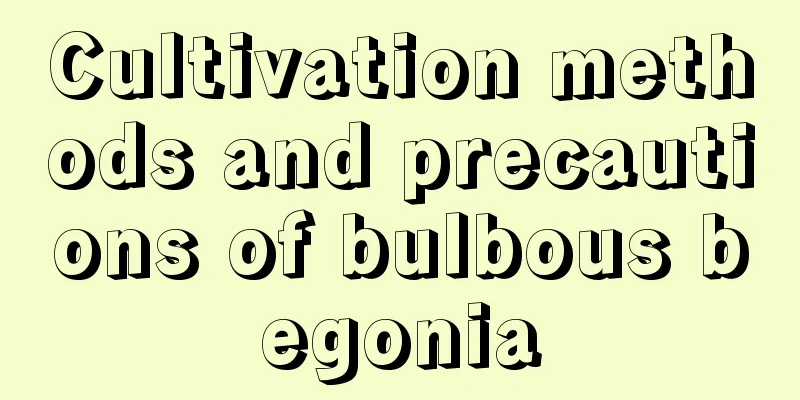Cultivation methods and precautions of bulbous begonia

Farming methodssoilTo grow bulbous begonias, the soil needs to be fertile, loose and breathable, rich in humus, and can be acidic. Generally, you can use garden soil, river sand, and leaf mold. In order to increase the fertility, you can add some base fertilizer. Light and temperatureBulbous begonias prefer a warm growing environment, preferably semi-shade, and are more afraid of the scorching heat of summer. The suitable temperature for growth is between 16℃ and 21℃, and it is not cold-resistant. Basically, if the temperature exceeds 30℃, the stems and leaves may wither, and in severe cases, the underground stems may die. A certain temperature must be maintained in winter, and the temperature for wintering should not be lower than 10℃. Bulbous begonias need long-day conditions to bloom well. Sufficient light needs to be maintained in the summer, but care should be taken to avoid direct sunlight in the summer and provide shade in time. The daylight hours are shorter in the winter, so sufficient light needs to be ensured. Watering and fertilizingBulbous begonia likes water and fertilizer, and requires a moist growing environment, but there should be no stagnant water because it is afraid of waterlogging. Watering needs to be reduced during the budding and flowering stages of bulbous begonias. In summer, you need to increase the air humidity by spraying water. In autumn and winter, the bulbous begonia gradually enters a dormant period, so watering should be reduced. Fertilization needs to be applied thinly and frequently. During the growth period, some decomposed thin fertilizer water can be applied every 10 minutes. During the flowering period, some fertilizers need to be applied to promote flowering. Note that no fertilization is required during summer and winter. PrecautionsReproduction methodThe main methods of propagation of bulbous begonia are sowing, cutting and cutting tubers. Seed propagation can be done in spring or autumn, and cuttings are mainly done in late spring and early summer. Pests and diseasesBulbous begonias need to be prevented from diseases and pests. The main diseases include root rot and stem rot, and the main pests are thrips, aphids and leaf rollers. It is necessary to improve the growth environment of bulbous begonias and spray pesticides in time. |
<<: Cultivation methods and precautions of Aquilegia
>>: Cultivation methods and precautions of Aralia ovata
Recommend
How to propagate Cineraria and what to pay attention to
How to reproduce Cineraria The main ways of propa...
What should I do if the new jade ornament grows too long?
What does the new jade ornament look like? The ne...
Cutting methods and precautions for Wanli Piaoxiang vine
The vine is native to tropical America and has th...
These “3 kinds” of water” will cause flowers to wither when watered in winter, so don’t take it lightly!
Winter is a difficult period for many plants beca...
The meaning and symbolism of orchids
1. Meaning The orchid symbolizes elegance, nobili...
What to do if the red maple leaves wither
Causes of withering The first step in dealing wit...
How to grow a money tree in a pot? How to grow a money tree in a pot
How to cultivate money tree in potted plants 1. P...
How to water Hawaiian coconut palms
Hawaiian Coconut Watering Tips Hawaiian coconut r...
The difference between Codonopsis and Angelica
1. Leaf Difference The leaves of Codonopsis pilos...
Does Euphorbia pilosa prefer water or drought?
Does Euphorbia pilosa prefer humidity or drought?...
The efficacy and function of the rich fern
one. Greening effect 1 This plant can grow in the...
What metaphor does wintersweet have in Feng Shui? Is it suitable for planting in the garden?
1. Metaphor in Feng Shui From the perspective of ...
Are carnations suitable for giving to patients? How many flowers should I send and what color is better?
1. Can I send a patient? Carnations are suitable ...
Pinch the half-dead flower a few times and new buds will immediately appear, and it will bloom in 10 days!
How to pinch jasmine flowers? The role of pinchin...
How to grow succulents
1. How to grow succulents 1. Light: Most succulen...









